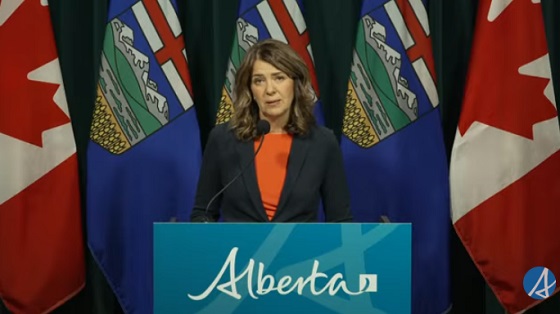Alberta
Province freezes funds for doctors and launches process to work out a new funding formula

New physician funding framework announce
Alberta will maintain physician funding at $5.4 billion, the highest level ever, and implement its final offer to the Alberta Medical Association (AMA) to avoid $2 billion in cost overruns.
Existing terms will remain in place until March 31, 2020. A new funding framework will then be introduced, in a multi-year process that will require consultation with the AMA at all stages. The new framework will make changes proposed during negotiations to prevent cost overruns, align benefit programs and administrative fees with those of comparable provinces, and improve services for patients.
The eleven consultation proposals will also be implemented on March 31. This includes phasing in changes to complex modifiers, reducing the rate physicians can charge for this billing code to $9 from $18, for a period of one year before the code is removed in 2021-22. In summer 2020, at the direction of the Minister of Health, the Government of Alberta will also introduce a new alternative relationship plan (ARP) with built-in transition benefits to encourage physicians to move from fee-for-service to a three-year contract.
“Our province is facing cost overruns of $2 billion in the next three years due solely to physician compensation. If left unaddressed, these costs would impede efforts to reduce surgical wait times, improve mental health and addiction services, and expand the number of continuing care beds. Despite repeated efforts, the AMA failed to put forward alternatives that would hold the line on physician compensation. The new framework announced today will prevent cost overruns, allow our province to improve services for patients, and still ensure that Alberta’s doctors are amongst the highest paid physicians in all of Canada.”
Background
- The new funding framework will maintain government’s current level of spending on physicians at $5.4 billion.
- The new funding framework avoids anticipated cost overruns of $2 billion over the next three years.
- Alberta has been spending more on physician salaries than other provinces, yet most of its health outcomes are below national averages.
- A doctor in Alberta earns approximately $90,000 more than a doctor in Ontario and physicians’ fees have almost tripled since 2002.
Elements of the new funding framework
- Changes to Alberta’s complex modifier billing system. The rate physicians are able to charge for complex modifiers will be reduced to $9 from $18 for a period of one year before this billing code is removed in 2021-22. Once the new framework is fully phased in, physicians will be able to bill an additional fee after spending 25 minutes with a complex patient case. Alberta remains the only province in Canada that allows for a top-up payment for complex visits.
- Removal of the comprehensive annual care plan from the list of insured services. Currently, physicians can also bill for a similar consultation called a comprehensive annual visit. No other province in Canada compensates physicians twice for annual care consultation.
- Implementation of a new daily cap, modelled after a cap in place in British Columbia, of 65 patients per day. Large patient loads can contribute to physician burnout and may compromise patient safety and quality of care.
- Removing physician overhead subsidies from all hospital-based services. Physicians who work in AHS facilities should not be billing for overhead costs that their community physician colleagues face, such as leases, hiring staff and purchasing equipment.
- Ending of clinical payments, or stipends, by AHS to physicians. This change ends duplication of payments to contracted physicians.
Timeline
- In September 2019, government provided notice to the AMA that it intended to begin negotiations on the AMA Agreement. The notification provided time for the AMA to prepare its proposals.
- In November 2019, negotiations began with the AMA to reach a new agreement; government began consultations on 11 proposed changes to the schedule of medical benefits (SOMB, or “insured services”).
- In January 2020, negotiations and consultations proceeded with no agreement reached. Mediation, on both the negotiation and consultation proposals, began January 31 and continued into February.
- The parties were not able to reach an agreement during mediation.
- Government will implement its final offer from the negotiating table, including the 11 consultation proposals, on March 31.
Alberta
‘Weird and wonderful’ wells are boosting oil production in Alberta and Saskatchewan

From the Canadian Energy Centre
Multilateral designs lift more energy with a smaller environmental footprint
A “weird and wonderful” drilling innovation in Alberta is helping producers tap more oil and gas at lower cost and with less environmental impact.
With names like fishbone, fan, comb-over and stingray, “multilateral” wells turn a single wellbore from the surface into multiple horizontal legs underground.
“They do look spectacular, and they are making quite a bit of money for small companies, so there’s a lot of interest from investors,” said Calin Dragoie, vice-president of geoscience with Calgary-based Chinook Consulting Services.
Dragoie, who has extensively studied the use of multilateral wells, said the technology takes horizontal drilling — which itself revolutionized oil and gas production — to the next level.
“It’s something that was not invented in Canada, but was perfected here. And it’s something that I think in the next few years will be exported as a technology to other parts of the world,” he said.
Dragoie’s research found that in 2015 less than 10 per cent of metres drilled in Western Canada came from multilateral wells. By last year, that share had climbed to nearly 60 per cent.
Royalty incentives in Alberta have accelerated the trend, and Saskatchewan has introduced similar policy.
Multilaterals first emerged alongside horizontal drilling in the late 1990s and early 2000s, Dragoie said. But today’s multilaterals are longer, more complex and more productive.
The main play is in Alberta’s Marten Hills region, where producers are using multilaterals to produce shallow heavy oil.
Today’s average multilateral has about 7.5 horizontal legs from a single surface location, up from four or six just a few years ago, Dragoie said.
One record-setting well in Alberta drilled by Tamarack Valley Energy in 2023 features 11 legs stretching two miles each, for a total subsurface reach of 33 kilometres — the longest well in Canada.
By accessing large volumes of oil and gas from a single surface pad, multilaterals reduce land impact by a factor of five to ten compared to conventional wells, he said.
The designs save money by skipping casing strings and cement in each leg, and production is amplified as a result of increased reservoir contact.
Here are examples of multilateral well design. Images courtesy Chinook Consulting Services.
Parallel
Fishbone
Fan
Waffle
Stingray
Frankenwells
Alberta
Alberta to protect three pro-family laws by invoking notwithstanding clause

From LifeSiteNews
Premier Danielle Smith said her government will use a constitutional tool to defend a ban on transgender surgery for minors and stopping men from competing in women’s sports.
Alberta Premier Danielle Smith said her government will use a rare constitutional tool, the notwithstanding clause, to ensure three bills passed this year — a ban on transgender surgery for minors, stopping men from competing in women’s sports, and protecting kids from extreme aspects of the LGBT agenda — stand and remain law after legal attacks from extremist activists.
Smith’s United Conservative Party (UCP) government stated that it will utilize a new law, Bill 9, to ensure that laws passed last year remain in effect.
“Children deserve the opportunity to grow into adulthood before making life-altering decisions about their gender and fertility,” Smith said in a press release sent to LifeSiteNews and other media outlets yesterday.
“By invoking the notwithstanding clause, we’re ensuring that laws safeguarding children’s health, education and safety cannot be undone – and that parents are fully involved in the major decisions affecting their children’s lives. That is what Albertans expect, and that is what this government will unapologetically defend.”
Alberta Justice Minister and Attorney General Mickey Amery said that the laws passed last year are what Albertans voted for in the last election.
“These laws reflect an overwhelming majority of Albertans, and it is our responsibility to ensure that they will not be overturned or further delayed by activists in the courts,” he noted.
“The notwithstanding clause reinforces democratic accountability by keeping decisions in the hands of those elected by Albertans. By invoking it, we are providing certainty that these protections will remain in place and that families can move forward with clarity and confidence.”
The Smith government said the notwithstanding clause will apply to the following pieces of legislation:
-
Bill 26, the Health Statutes Amendment Act, 2024, prohibits both gender reassignment surgery for children under 18 and the provision of puberty blockers and hormone treatments for the purpose of gender reassignment to children under 16.
-
Bill 27, the Education Amendment Act, 2024, requires schools to obtain parental consent when a student under 16 years of age wishes to change his or her name or pronouns for reasons related to the student’s gender identity, and requires parental opt-in consent to teaching on gender identity, sexual orientation or human sexuality.
-
Bill 29, the Fairness and Safety in Sport Act, requires the governing bodies of amateur competitive sports in Alberta to implement policies that limit participation in women’s and girls’ sports to those who were born female.”
Bill 26 was passed in December of 2024, and it amends the Health Act to “prohibit regulated health professionals from performing sex reassignment surgeries on minors.”
As reported by LifeSiteNews, pro-LGBT activist groups, with the support of Alberta’s opposition New Democratic Party (NDP), have tried to stop the bill via lawsuits. It prompted the Smith government to appeal a court injunction earlier this year blocking the province’s ban on transgender surgeries and drugs for gender-confused minors.
Last year, Smith’s government also passed Bill 27, a law banning schools from hiding a child’s pronoun changes at school that will help protect kids from the extreme aspects of the LGBT agenda.
Bill 27 will also empower the education minister to, in effect, stop the spread of extreme forms of pro-LGBT ideology or anything else to be allowed to be taught in schools via third parties.
Bill 29, which became law last December, bans gender-confused men from competing in women’s sports, the first legislation of its kind in Canada. The law applies to all school boards, universities, and provincial sports organizations.
Alberta’s notwithstanding clause is like all other provinces’ clauses and was a condition Alberta agreed to before it signed onto the nation’s 1982 constitution.
It is meant as a check to balance power between the court system and the government elected by the people. Once it is used, as passed in the legislature, a court cannot rule that the “legislation which the notwithstanding clause applies to be struck down based on the Charter of Rights and Freedoms, the Alberta Bill of Rights, or the Alberta Human Rights Act,” the Alberta government noted.
While Smith has done well on some points, she has still been relatively soft on social issues of importance to conservatives , such as abortion, and has publicly expressed pro-LGBT views, telling Jordan Peterson earlier this year that conservatives must embrace homosexual “couples” as “nuclear families.”
-

 Alberta2 days ago
Alberta2 days ago‘Weird and wonderful’ wells are boosting oil production in Alberta and Saskatchewan
-

 Alberta2 days ago
Alberta2 days agoAlberta to protect three pro-family laws by invoking notwithstanding clause
-

 Business2 days ago
Business2 days agoCanada is failing dismally at our climate goals. We’re also ruining our economy.
-

 Health1 day ago
Health1 day agoCDC’s Autism Reversal: Inside the Collapse of a 25‑Year Public Health Narrative
-

 Energy2 days ago
Energy2 days agoThe Carney Government is Hijacking the Phase “Energy Superpower” to Advance Their Agenda
-

 Crime1 day ago
Crime1 day agoCocaine, Manhunts, and Murder: Canadian Cartel Kingpin Prosecuted In US
-

 Health1 day ago
Health1 day agoBREAKING: CDC quietly rewrites its vaccine–autism guidance
-

 National1 day ago
National1 day agoPsyop-Style Campaign That Delivered Mark Carney’s Win May Extend Into Floor-Crossing Gambits and Shape China–Canada–US–Mexico Relations













